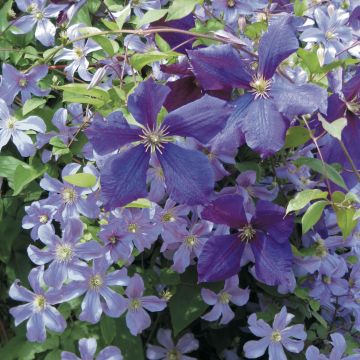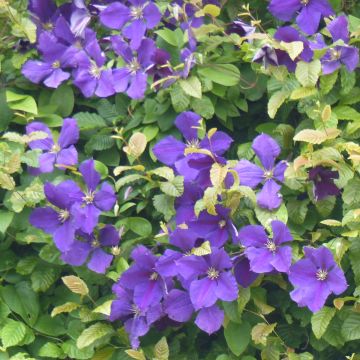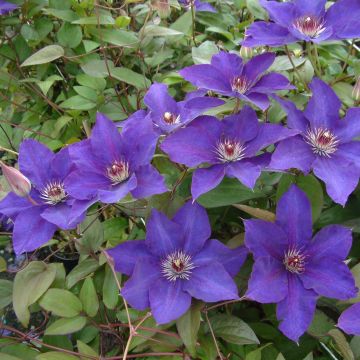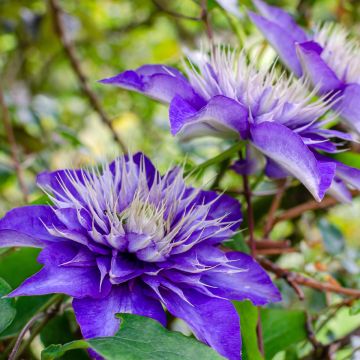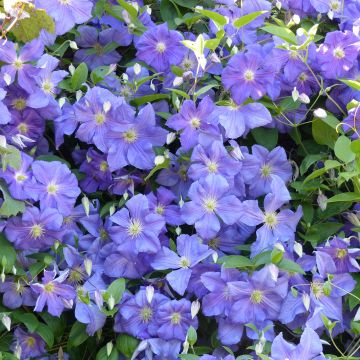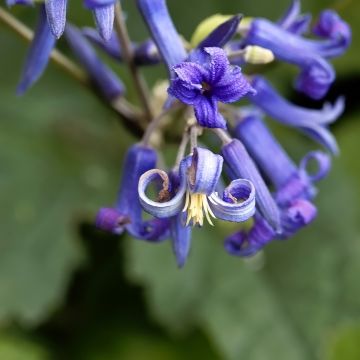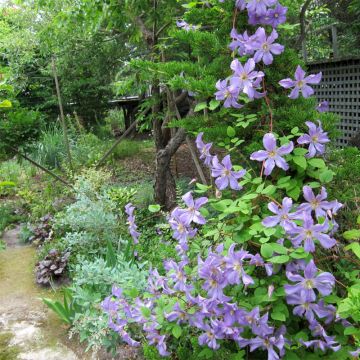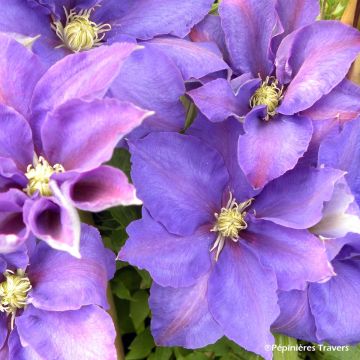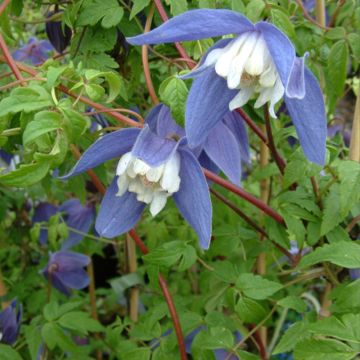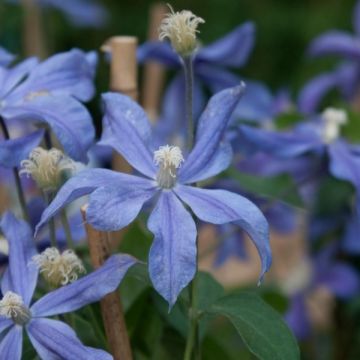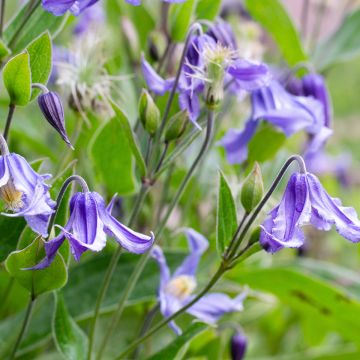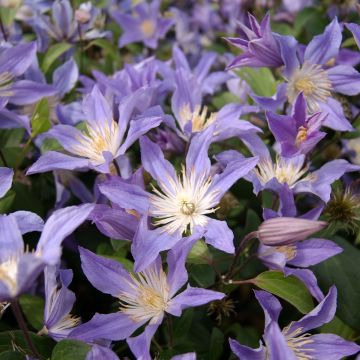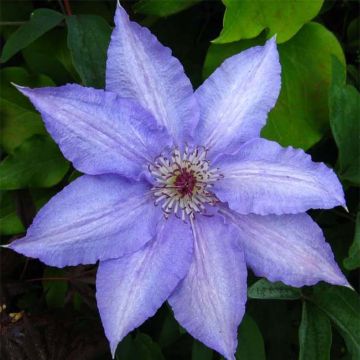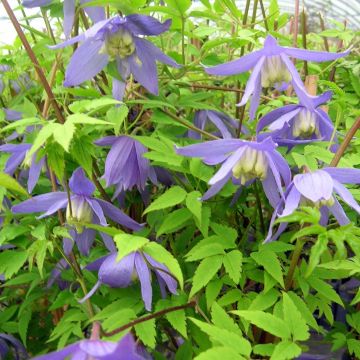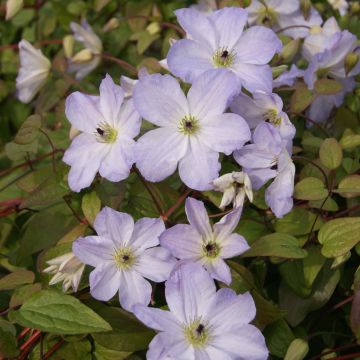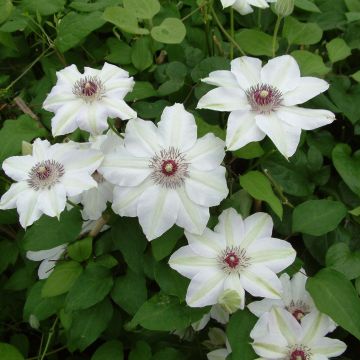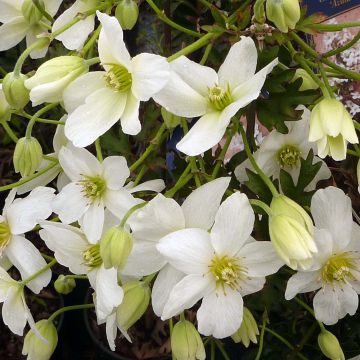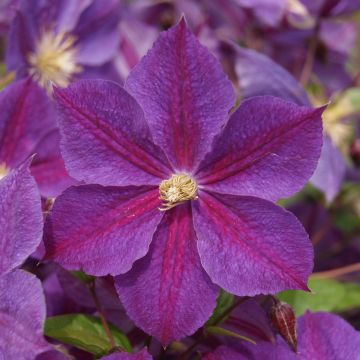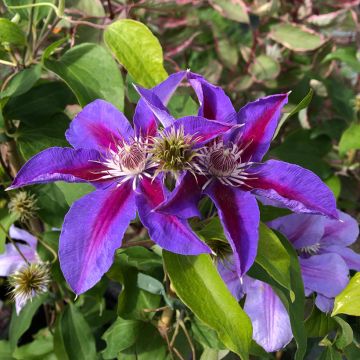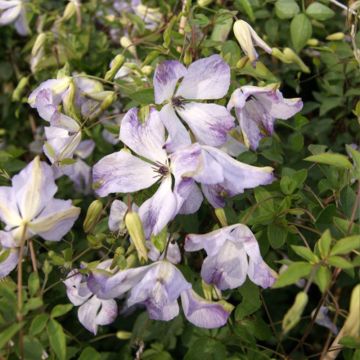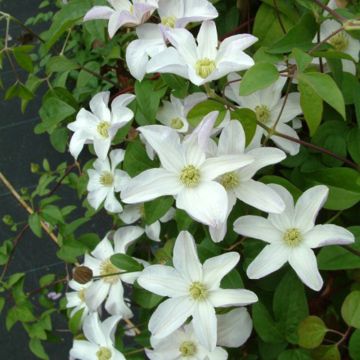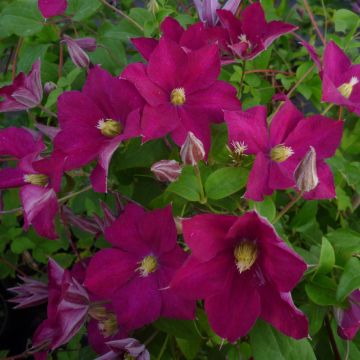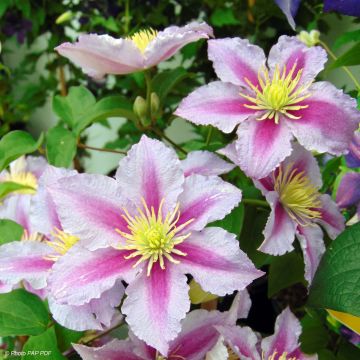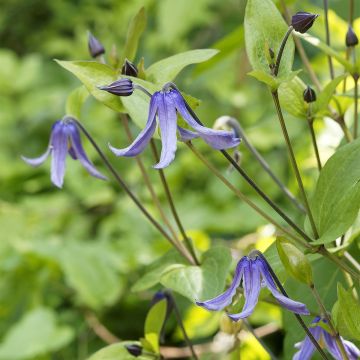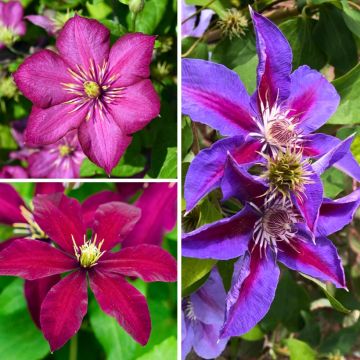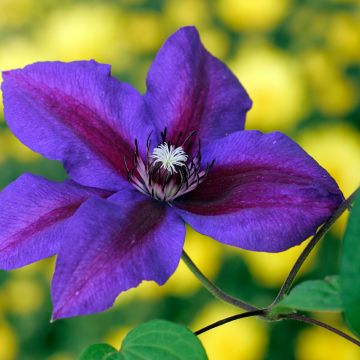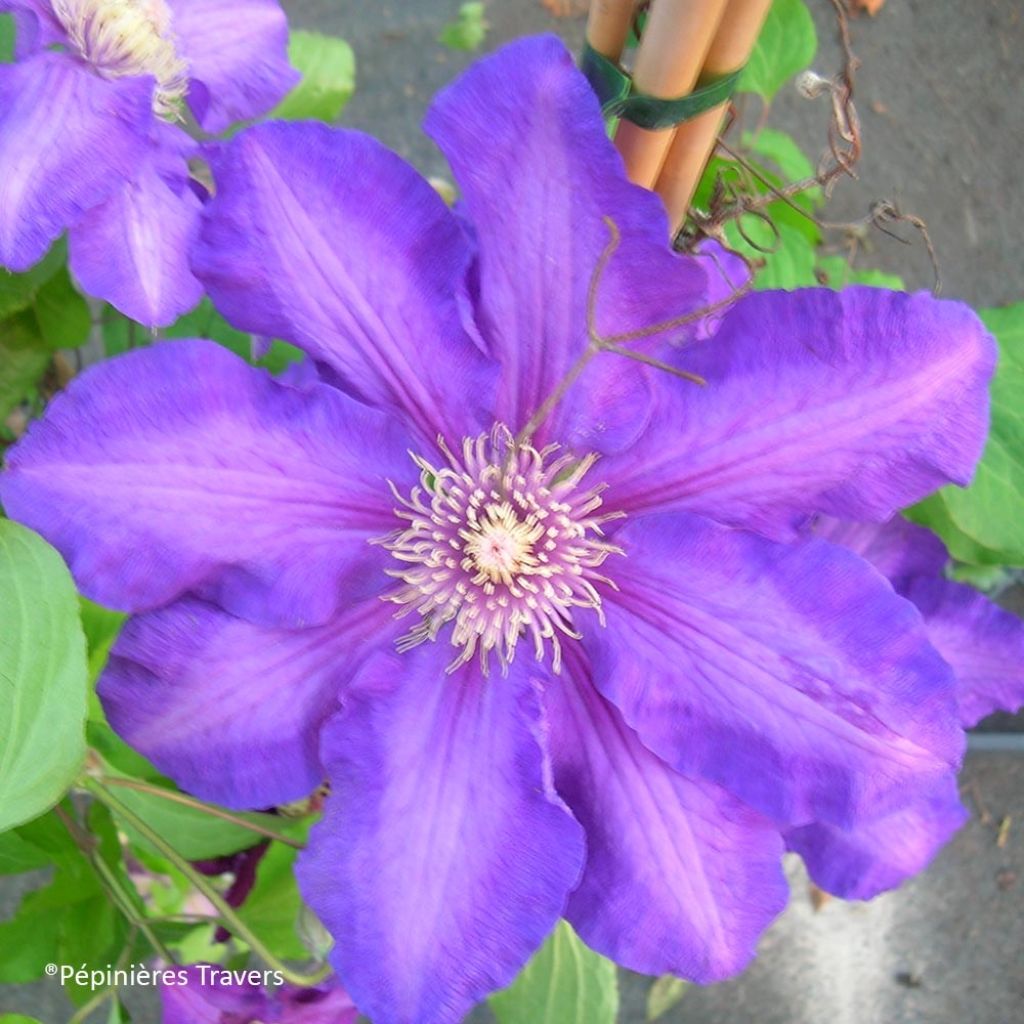

Clematis Kjell
Clematis Kjell
Clematis Kjell
Clematis 'Jessica'
Why not try an alternative variety in stock?
View all →This plant carries a 6 months recovery warranty
More information
We guarantee the quality of our plants for a full growing cycle, and will replace at our expense any plant that fails to recover under normal climatic and planting conditions.
From €5.90 for pickup delivery and €6.90 for home delivery
Express home delivery from €8.90.
Does this plant fit my garden?
Set up your Plantfit profile →
Description
Clematis 'Kjell', also known as C. 'Jessica', displays large sumptuous flowers measuring 14 to 16cm (6in) in diameter. They bloom in a gradient of blue-violet with yellow-cream stamens, which stand out in contrast. It is a deciduous climbing plant that blooms twice a year, with double flowers in spring and single flowers in autumn. Of medium size and growth, it is suitable for small and large gardens, in pots or in the ground. Plant its base in a cool, shaded area with its head in the sun.
The cultivar 'Kjell' is a hybrid resulting from the cross-breeding of C. Alabast 'Poulala' with C. 'Vino', obtained by S. Widberg in Sweden. It is a deciduous climber belonging to the Ranunculaceae family. Like most of its cousins, it prefers light, deep, moist, and fertile soil that is preferably neutral. It enjoys a sunny or partially shaded position, with its base always in shade. It resists cold temperatures and is not afraid of frost, even if prolonged. However, it does not tolerate stagnant humidity, so the substrate must be well-drained and watering should be moderate (if necessary, during the first year). It can be grown in a container if the pot is large enough (minimum 60cm (24in) in diameter.
Clematis 'Kjell' can reach a height of up to 2.5m (8ft) and a width of 1m (3ft). It is a Group 2 clematis, which means it has large flowers and blooms in spring, with a second flowering in late summer. The lignified stems from the previous year bear the spring flowers, which are sometimes double. The herbaceous branches from the current year bear the late summer flowering. The second wave of flowers are single stars. They are normally composed of 6 to 8 large petals. Initially purple-red, they lighten to a gradient of blue-violet with much lighter medians and red-purple markings as they approach the centre. They have a large, densely packed heart of bristly stamens. They later transform into dry fruits with persistent feathery aigrettes in winter. The deciduous and medium green leaves are composed of 3 to 5 leaflets. They are carried by voluble petioles called tendrils that wrap themselves around their support.
Plant spring bulbs and ground-cover perennials, such as white-flowering geraniums, at its base and enjoy the show with minimal maintenance. If you have a larger space, this vigorous clematis can weave through bushes or up a column, adding verticality to a colourful flower bed. Large-flowered repeat-blooming clematis are the best companions for roses. Its fairly dark flowering will be even more enhanced when paired with large shrubs with light green, variegated, and golden foliage, or up a sunny pergola with other contrasting climbers such as the cream-coloured flowers of Akebia 'Cream Form'. It will perfectly complement blue and pink schemes.
Report an error about the product description
Clematis Kjell in pictures
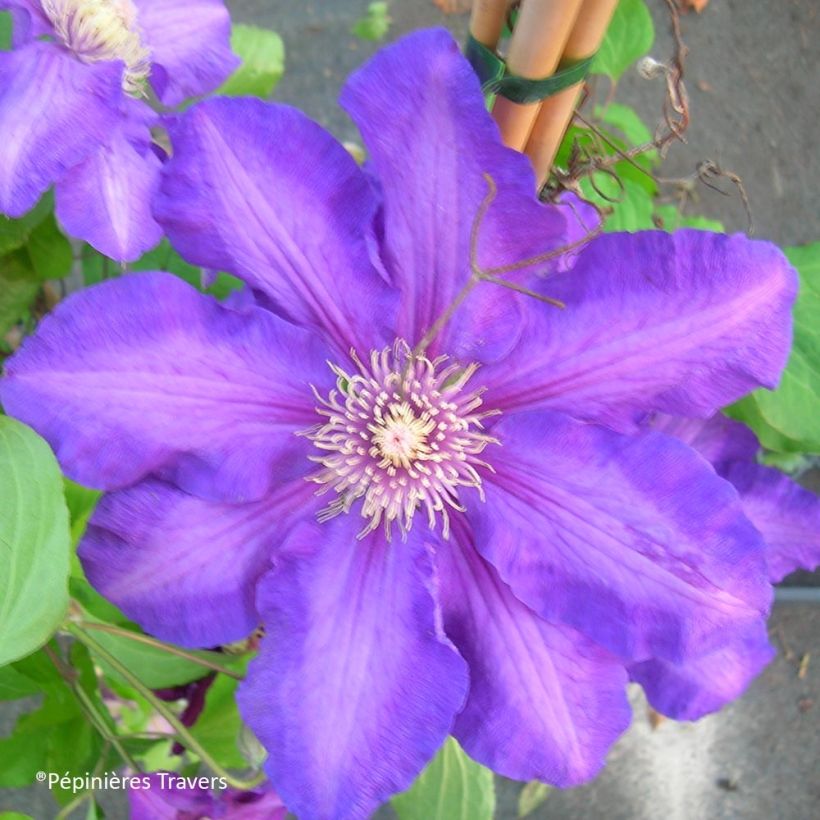

Plant habit
Flowering
Foliage
Botanical data
Clematis
Kjell
Ranunculaceae
Clematis 'Jessica'
Cultivar or hybrid
Other Clematis A to Z
Planting and care
Plant in spring or autumn. It prefers moderately moist but not waterlogged soil that is deep, well-cultivated, drained, and rich. Plant at a depth of 5cm (2in), with the root ball placed diagonally or even lying on the ground. The head should be in the sun (or partial shade) and the base in the shade. You can place a flat tile in front of the stump or use ground cover plants to provide the necessary shade. Cover the base with a small mound of soil to encourage new shoots. After planting, cut the stems back to 30cm (12in) from the base, above a pair of buds.
Train them loosely to help the plant cling on its own.
Maintenance pruning should be done after flowering (in midsummer) to remove faded flowers and shorten the stems that have bloomed. This will help the plant to produce new shoots for a second flowering. More vigorous pruning can be done in spring to cut back certain stems more severely, but not necessarily every year.
Keep an eye out for pests such as aphids, slugs, and snails.
Planting period
Intended location
Care
This item has not been reviewed yet - be the first to leave a review about it.
Clematis
Haven't found what you were looking for?
Hardiness is the lowest winter temperature a plant can endure without suffering serious damage or even dying. However, hardiness is affected by location (a sheltered area, such as a patio), protection (winter cover) and soil type (hardiness is improved by well-drained soil).

Photo Sharing Terms & Conditions
In order to encourage gardeners to interact and share their experiences, Promesse de fleurs offers various media enabling content to be uploaded onto its Site - in particular via the ‘Photo sharing’ module.
The User agrees to refrain from:
- Posting any content that is illegal, prejudicial, insulting, racist, inciteful to hatred, revisionist, contrary to public decency, that infringes on privacy or on the privacy rights of third parties, in particular the publicity rights of persons and goods, intellectual property rights, or the right to privacy.
- Submitting content on behalf of a third party;
- Impersonate the identity of a third party and/or publish any personal information about a third party;
In general, the User undertakes to refrain from any unethical behaviour.
All Content (in particular text, comments, files, images, photos, videos, creative works, etc.), which may be subject to property or intellectual property rights, image or other private rights, shall remain the property of the User, subject to the limited rights granted by the terms of the licence granted by Promesse de fleurs as stated below. Users are at liberty to publish or not to publish such Content on the Site, notably via the ‘Photo Sharing’ facility, and accept that this Content shall be made public and freely accessible, notably on the Internet.
Users further acknowledge, undertake to have ,and guarantee that they hold all necessary rights and permissions to publish such material on the Site, in particular with regard to the legislation in force pertaining to any privacy, property, intellectual property, image, or contractual rights, or rights of any other nature. By publishing such Content on the Site, Users acknowledge accepting full liability as publishers of the Content within the meaning of the law, and grant Promesse de fleurs, free of charge, an inclusive, worldwide licence for the said Content for the entire duration of its publication, including all reproduction, representation, up/downloading, displaying, performing, transmission, and storage rights.
Users also grant permission for their name to be linked to the Content and accept that this link may not always be made available.
By engaging in posting material, Users consent to their Content becoming automatically accessible on the Internet, in particular on other sites and/or blogs and/or web pages of the Promesse de fleurs site, including in particular social pages and the Promesse de fleurs catalogue.
Users may secure the removal of entrusted content free of charge by issuing a simple request via our contact form.
The flowering period indicated on our website applies to countries and regions located in USDA zone 8 (France, the United Kingdom, Ireland, the Netherlands, etc.)
It will vary according to where you live:
- In zones 9 to 10 (Italy, Spain, Greece, etc.), flowering will occur about 2 to 4 weeks earlier.
- In zones 6 to 7 (Germany, Poland, Slovenia, and lower mountainous regions), flowering will be delayed by 2 to 3 weeks.
- In zone 5 (Central Europe, Scandinavia), blooming will be delayed by 3 to 5 weeks.
In temperate climates, pruning of spring-flowering shrubs (forsythia, spireas, etc.) should be done just after flowering.
Pruning of summer-flowering shrubs (Indian Lilac, Perovskia, etc.) can be done in winter or spring.
In cold regions as well as with frost-sensitive plants, avoid pruning too early when severe frosts may still occur.
The planting period indicated on our website applies to countries and regions located in USDA zone 8 (France, United Kingdom, Ireland, Netherlands).
It will vary according to where you live:
- In Mediterranean zones (Marseille, Madrid, Milan, etc.), autumn and winter are the best planting periods.
- In continental zones (Strasbourg, Munich, Vienna, etc.), delay planting by 2 to 3 weeks in spring and bring it forward by 2 to 4 weeks in autumn.
- In mountainous regions (the Alps, Pyrenees, Carpathians, etc.), it is best to plant in late spring (May-June) or late summer (August-September).
The harvesting period indicated on our website applies to countries and regions in USDA zone 8 (France, England, Ireland, the Netherlands).
In colder areas (Scandinavia, Poland, Austria...) fruit and vegetable harvests are likely to be delayed by 3-4 weeks.
In warmer areas (Italy, Spain, Greece, etc.), harvesting will probably take place earlier, depending on weather conditions.
The sowing periods indicated on our website apply to countries and regions within USDA Zone 8 (France, UK, Ireland, Netherlands).
In colder areas (Scandinavia, Poland, Austria...), delay any outdoor sowing by 3-4 weeks, or sow under glass.
In warmer climes (Italy, Spain, Greece, etc.), bring outdoor sowing forward by a few weeks.

































